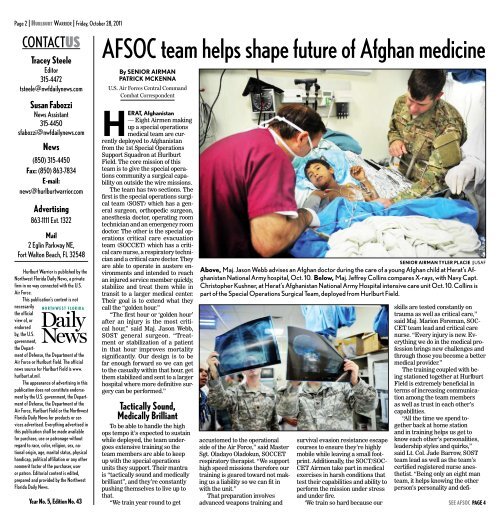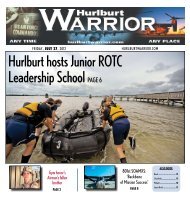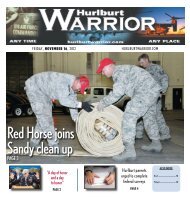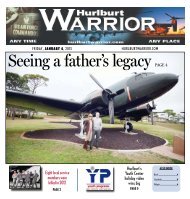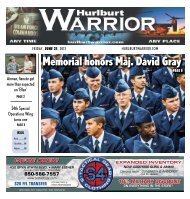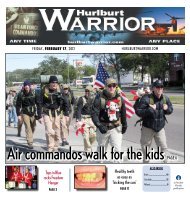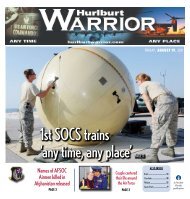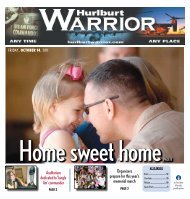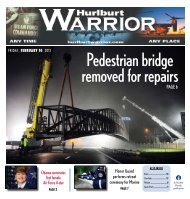doctor leaves private practice to become airman ... - Hurlburt Warrior
doctor leaves private practice to become airman ... - Hurlburt Warrior
doctor leaves private practice to become airman ... - Hurlburt Warrior
Create successful ePaper yourself
Turn your PDF publications into a flip-book with our unique Google optimized e-Paper software.
Page | <strong>Hurlburt</strong> <strong>Warrior</strong> | Friday, Oc<strong>to</strong>ber 28, 2011<br />
ContactUs<br />
Tracey Steele<br />
Edi<strong>to</strong>r<br />
315-4472<br />
tsteele@nwfdailynews.com<br />
Susan Fabozzi<br />
News Assistant<br />
315-4450<br />
sfabozzi@nwfdailynews.com<br />
News<br />
(850) 315-4450<br />
Fax: (850) 863-7834<br />
E-mail:<br />
news@hurlburtwarrior.com<br />
Advertising<br />
863-1111 Ext. 1322<br />
Mail<br />
2 Eglin Parkway NE,<br />
Fort Wal<strong>to</strong>n Beach, FL 32548<br />
<strong>Hurlburt</strong> <strong>Warrior</strong> is published by the<br />
Northwest Florida Daily News, a <strong>private</strong><br />
firm in no way connected with the U.S.<br />
Air Force.<br />
This publication’s content is not<br />
necessarily<br />
the official<br />
view of, or<br />
endorsed<br />
by, the U.S.<br />
government,<br />
the Department<br />
of Defense, the Department of the<br />
Air Force or <strong>Hurlburt</strong> Field. The official<br />
news source for <strong>Hurlburt</strong> Field is www.<br />
hurlburt.af.mil.<br />
The appearance of advertising in this<br />
publication does not constitute endorsement<br />
by the U.S. government, the Department<br />
of Defense, the Department of the<br />
Air Force, <strong>Hurlburt</strong> Field or the Northwest<br />
Florida Daily News for products or services<br />
advertised. Everything advertised in<br />
this publication shall be made available<br />
for purchase, use or patronage without<br />
regard <strong>to</strong> race, color, religion, sex, national<br />
origin, age, marital status, physical<br />
handicap, political affiliation or any other<br />
nonmerit fac<strong>to</strong>r of the purchaser, user<br />
or patron. Edi<strong>to</strong>rial content is edited,<br />
prepared and provided by the Northwest<br />
Florida Daily News.<br />
Year No. 5, Edition No. 43<br />
AFSOC team helps shape future of Afghan medicine<br />
By Senior Airman .<br />
Patrick McKenna<br />
U.S. Air Forces Central Command<br />
Combat Correspondent<br />
HERAT, Afghanistan<br />
— Eight Airmen making<br />
up a special operations<br />
medical team are currently<br />
deployed <strong>to</strong> Afghanistan<br />
from the 1st Special Operations<br />
Support Squadron at <strong>Hurlburt</strong><br />
Field. The core mission of this<br />
team is <strong>to</strong> give the special operations<br />
community a surgical capability<br />
on outside the wire missions.<br />
The team has two sections. The<br />
first is the special operations surgical<br />
team (SOST) which has a general<br />
surgeon, orthopedic surgeon,<br />
anesthesia <strong>doc<strong>to</strong>r</strong>, operating room<br />
technician and an emergency room<br />
<strong>doc<strong>to</strong>r</strong>. The other is the special operations<br />
critical care evacuation<br />
team (SOCCET) which has a critical<br />
care nurse, a respira<strong>to</strong>ry technician<br />
and a critical care <strong>doc<strong>to</strong>r</strong>. They<br />
are able <strong>to</strong> operate in austere environments<br />
and intended <strong>to</strong> reach<br />
an injured service member quickly,<br />
stabilize and treat them while in<br />
transit <strong>to</strong> a larger medical center.<br />
Their goal is <strong>to</strong> extend what they<br />
call the “golden hour.”<br />
“The first hour or ‘golden hour’<br />
after an injury is the most critical<br />
hour,” said Maj. Jason Webb,<br />
SOST general surgeon. “Treatment<br />
or stabilization of a patient<br />
in that hour improves mortality<br />
significantly. Our design is <strong>to</strong> be<br />
far enough forward so we can get<br />
<strong>to</strong> the casualty within that hour, get<br />
them stabilized and sent <strong>to</strong> a larger<br />
hospital where more definitive surgery<br />
can be performed.”<br />
Tactically Sound,<br />
Medically Brilliant<br />
To be able <strong>to</strong> handle the high<br />
ops tempo it’s expected <strong>to</strong> sustain<br />
while deployed, the team undergoes<br />
extensive training so the<br />
team members are able <strong>to</strong> keep<br />
up with the special operations<br />
units they support. Their mantra<br />
is “tactically sound and medically<br />
brilliant”, and they’re constantly<br />
pushing themselves <strong>to</strong> live up <strong>to</strong><br />
that.<br />
“We train year round <strong>to</strong> get<br />
Senior Airman Tyler Placie | USAF<br />
Above, Maj. Jason Webb advises an Afghan <strong>doc<strong>to</strong>r</strong> during the care of a young Afghan child at Herat’s Afghanistan<br />
National Army hospital, Oct. 10. Below, Maj. Jeffrey Collins compares X-rays, with Navy Capt.<br />
Chris<strong>to</strong>pher Kushner, at Herat’s Afghanistan National Army Hospital intensive care unit Oct. 10. Collins is<br />
part of the Special Operations Surgical Team, deployed from <strong>Hurlburt</strong> Field.<br />
accus<strong>to</strong>med <strong>to</strong> the operational<br />
side of the Air Force,” said Master<br />
Sgt. Oladayo Oladokun, SOCCET<br />
respira<strong>to</strong>ry therapist. “We support<br />
high speed missions therefore our<br />
training is geared <strong>to</strong>ward not making<br />
us a liability so we can fit in<br />
with the unit.”<br />
That preparation involves<br />
advanced weapons training and<br />
survival evasion resistance escape<br />
courses <strong>to</strong> ensure they’re highly<br />
mobile while leaving a small footprint.<br />
Additionally, the SOCT/SOC-<br />
CET Airmen take part in medical<br />
exercises in harsh conditions that<br />
test their capabilities and ability <strong>to</strong><br />
perform the mission under stress<br />
and under fire.<br />
‘We train so hard because our<br />
skills are tested constantly on<br />
trauma as well as critical care,”<br />
said Maj. Marion Foreman, SOC-<br />
CET team lead and critical care<br />
nurse. “Every injury is new. Everything<br />
we do in the medical profession<br />
brings new challenges and<br />
through those you <strong>become</strong> a better<br />
medical provider.”<br />
The training coupled with being<br />
stationed <strong>to</strong>gether at <strong>Hurlburt</strong><br />
Field is extremely beneficial in<br />
terms of increasing communication<br />
among the team members<br />
as well as trust in each other’s<br />
capabilities.<br />
“All the time we spend <strong>to</strong>gether<br />
back at home station<br />
and in training helps us get <strong>to</strong><br />
know each other’s personalities,<br />
leadership styles and quirks,”<br />
said Lt. Col. Jade Barrow, SOST<br />
team lead as well as the team’s<br />
certified registered nurse anesthetist.<br />
“Being only an eight man<br />
team, it helps knowing the other<br />
person’s personality and defi-<br />
See afsoc page 4


